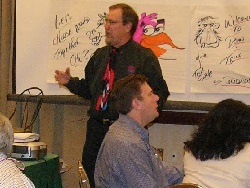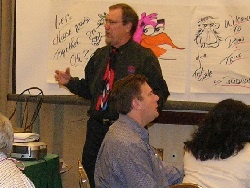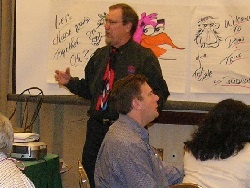


Getting participants in a presentation or training program to listen and take what they heard back to the workplace is often a challenge. Here are six strategies that can help increase transfer of knowledge from the classroom to the job.
Relate to the workplace. By showing participants how they can immediately benefit and apply what they have learned to their jobs, you can gain buy-in or interest. Explain this relationship early in your presentation as part of your behavioral learning objectives. Also, throughout your program, do short reviews and ask how participants see themselves using the information in their workplace.
Involve participants. No matter how good you are as a speaker, trainer or facilitator, most people have an attention span of less that seven or eight minutes. The average adult in the United States speaks at approximately 125-150 words per minute. Most people's brains can comprehend and absorb 4-6 times that amount of information. That means there is a "listening gap" which allows participants to daydream or drift off into the ozone while you are speaking. Getting them actively involved through discussions, activities, or written assessments, and making sure that all of these vehicles relate to the topic, is key in holding interest. You should plan to change your format about every 8-15 minutes. Mix up your strategies to address the learning needs of the visual, auditory and kinesthetic learners. Do not overlook either group for long or they may become preoccupied and miss important information.
Be flexible. If you move through your prepared material and realize that you are losing part of your audience, be prepared to shift gears. Take a quick check through an "Interim Review" in which you do a show of hands, a quick written paper and pencil feedback activity, or a flip chart activity where you gather their thoughts on how the session is going. If you find you are still hitting the mark, keep going, if not, make adjustments in format and content so that you make the experience meaningful for participants and you.
Treat participants as adults. This does not mean you cannot incorporate games, incentives and FUN stuff into your programs. Contrarily, you can often use such tools to hold attention and increase transfer of knowledge. However, you should value participants for what they know and can contribute to the environment and topic. To maximize access to their strengths, build in opportunities for self-disclosure, discussion, sharing of views and ideas, and problem-solving. Let them play an active role in their own learning.
Create a functional learning environment. Organize tables, materials and equipment for optimal viewing before participants arrive to ensure more efficiency and cut down on lost time during the program. Also, do not forget to make your facility, materials, activities, and overall environment accessible to all participants. Failure to consider this factor may limit the learning opportunities for someone with a disability and also put you and your organization at liability for violating state and federal disability laws. The environment should facilitate discussion and the program format.
Make the experience FUN! There are many creative ways to involve and engage participants. Remember that adults are "just kids with big bodies" to some extent. They sometimes need permission to have fun, relax, and to function in ways that are not typical in a training environment. By tying in contests, props, prizes, games, activities, or other similar strategies to support your program content, you can generate interest and reinforce learning at the same time. A key to remember is that you should have a program related purpose for everything you do and relate this purpose to your participants. Some people may not see the tie- in and think you frivolous or go back to the workplace and talk about all the FUN they had. Their sponsor may not understand the relevancy and you could lose support to send other participants in the future.
There you have it, a half dozen suggestions. Maybe not brain surgery, but certainly guaranteed to help make your learning events more effective and provide opportunities for expanded learning.
©Copyright by Robert (Bob) W. Lucas, president of Creative Presentation Resources, Inc, a creative training and presentation products company in Casselberry, Florida. He has over three decades of experience training adults. He is a very active in ASTD and is a past president of the Central Florida Chapter.
Don't miss out on updates and chances
to sharpen your skills with participant-centered learning.




3740 N Chestnut St #113 - Chaska, MN 55318-3053